 W
WBeatus vir are the first words in the Latin Vulgate Bible of both Psalm 1 and Psalm 112. In each case, the words are used to refer to frequent and significant uses of these psalms in art, although the two psalms are prominent in different fields, art in the case of Psalm 1 and music in the case of Psalm 112. In psalter manuscripts, the initial letter B of Beatus is often rendered prominently as a Beatus initial.
 W
WBlickling Psalter, also known as Lothian Psalter, is an 8th-century Insular illuminated manuscript containing a Roman Psalter with two additional sets of Old English glosses.
 W
WThe Cathach of St. Columba is a late 6th century Insular psalter.
 W
WChludov Psalter is an illuminated marginal Psalter made in the middle of the 9th Century. It is a unique monument of Byzantine art at the time of the Iconoclasm, one of only three illuminated Byzantine Psalters to survive from the 9th century.
 W
WThe Daskal Philip Psalter is a 17th-century Bulgarian illuminated psalter. It was produced in 1692.
 W
WThe Egbert Psalter is a medieval illuminated manuscript Psalter preserved in the municipal museum of Cividale, Italy. The psalter is an example of the illuminated manuscripts associated with the Ottonian Renaissance.
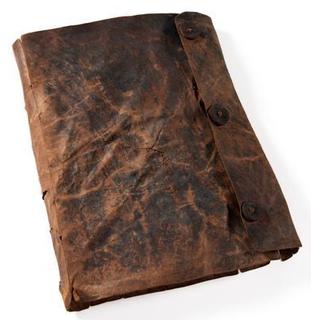 W
WThe Faddan More Psalter is an early medieval Christian psalter or text of the book of Psalms, discovered in a peat bog in July 2006, in the townland of Faddan More in north County Tipperary, Ireland. The manuscript was probably written in about 800 CE in one of a number of monasteries in the area. A unique feature is that the inside of the leather cover is lined with papyrus, probably as a stiffening, an indication of the links between the Irish and Coptic churches at the time. After several years of conservation work, the psalter went on display at the National Museum of Ireland in Kildare St, Dublin in June 2011.
 W
WThe Felbrigge Psalter is an illuminated manuscript Psalter from mid-13th century England that has an embroidered bookbinding which probably dates to the early 14th century. It is the oldest surviving book from England to have an embroidered binding. The embroidery is worked in fine linen with an illustration of the Annunciation on the front cover and an illustration of the Crucifixion on the back.
 W
WThe Gorleston Psalter is a 14th-century manuscript notable for containing early music instruction and for its humorous marginalia. It is named for the town of Gorleston in Norfolk.
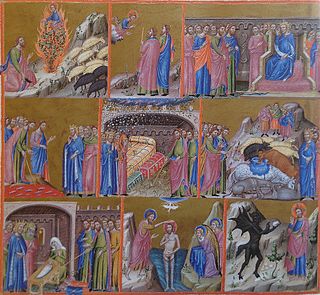 W
WThe Great Canterbury Psalter, Anglo-Catalan Psalter or Paris Psalter is an early 13th- and mid 14th-century illuminated manuscript with the shelfmark MS lat. 8846 in the Bibliothèque nationale de France in Paris. It was made in two different locations and moments in time: at Canterbury around 1200 and in Catalonia around 1340. It is the last of a series of copies of the Utrecht Psalter made in Canterbury, following the Harley Psalter and the Eadwine Psalter.
 W
WThe Harley Psalter is an illuminated manuscript of the second and third decades of the 11th century, with some later additions. It is a Latin psalter on vellum, measures 380 x 310 mm and was probably produced at Christ Church, Canterbury. The most likely patron of such a costly work would have been the Archbishop of Canterbury at the time, possibly Æthelnoth, who was consecrated in 1020 and remained at Canterbury until 1038.
 W
WThe Howard Psalter and Hours is a 14th-century illuminated prayerbook. It includes a liturgical Psalter with canticles and litany, the Office of the Dead, a calendar of East Anglian origin and an incomplete Hours of the Passion. It was produced between 1310 and 1320. It is written in Latin in a Gothic script in two columns per page. There are 115 extant folios which measure 360 by 235 mm. The text block occupies an area of 250 by 166 mm. It is bound together with the De Lisle Psalter, a contemporary psalter.
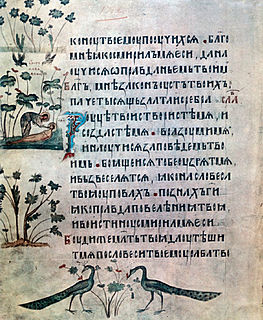 W
WThe Kiev Psalter of 1397, or Spiridon Psalter, is one of the most famous East Slavic illuminated manuscripts, containing over three hundred miniatures. It was written in 1397 by the scribe, Archdeacon Spiridon in Kiev, "at the command of Bishop Mikhail"; however, both scribe and patron had recently arrived from Moscow, and the decorations were probably added there later, in a refined and lively style, closely following a Byzantine 11th century Psalter.
 W
WThe Luttrell Psalter is an illuminated psalter commissioned by Sir Geoffrey Luttrell (1276–1345), lord of the manor of Irnham in Lincolnshire, written and illustrated on parchment circa 1320–1340 in England by anonymous scribes and artists.
 W
WThe Macclesfield Psalter is a lavishly illuminated manuscript probably produced c. 1320–30 in East Anglia. The psalter, or book of Psalms, contains 252 beautifully illustrated pages and is named after its most recent owner, the Earl of Macclesfield.
 W
WThe Munich Serbian Psalter is a 14th-century illuminated psalter written in Church Slavonic of the Serbian recension. With its 229 leaves illustrated with 148 miniatures, it is regarded as the most extensively illuminated Serbian manuscript book. It was written after 1370 in Moravian Serbia, either for its ruler Prince Lazar, or more likely, for his successor Stefan Lazarević. The book was rebound in 1630 by Serbian Patriarch Pajsije. It was taken to Bavaria in the late 17th century, and has been kept in the Bavarian State Library in Munich since the beginning of the 19th century.
 W
WThe Peterborough Psalter is a name given to two different illuminated manuscripts psalters produced in the scriptorium of Peterborough Abbey. One, from the early 13th century, is now in the Fitzwilliam Museum, Cambridge; the other, from the early 14th century, in the Royal Library of Belgium.
 W
WThe Psalter is a medieval illuminated manuscript, a psalter made in Flanders c. 1500–35. It belongs to the Royal Library, Denmark. The quality of its illuminations has been described as "unique".
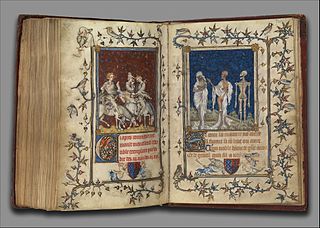 W
WThe Psalter of Bonne de Luxembourg is a small 14th-century illuminated manuscript in tempera, grisaille, ink and gold leaf on vellum. It is held in the collection of The Cloisters, New York, where it is usually on display.
 W
WThe Psalter of Henry VIII is a 16th-century illuminated psalter that belonged to Henry VIII of England. It is now in the British Library as MS Royal 2 A xvi. The king commissioned the book in the early 1540s from the French illuminator Jean Mallard, who had at one time worked for Francis I. The psalter contains eight miniatures, amongst them scenes of Henry playing the harp with his jester Will Somers in attendance, and of the king reading in his bedroom. Two scenes show Henry as King David: in one killing Goliath, in the other in the role of a penitent. The book has marginal annotations made by the king.
 W
WTwo lavishly illustrated illuminated manuscript psalters are known as the Psalter of Saint Louis as they belonged to the canonized King Louis IX of France. They are now in Paris and Leiden, and are respectively good examples of French Gothic and English Romanesque illumination.
 W
WThe Queen Mary Psalter is a fourteenth-century English psalter named after Mary I of England, who gained possession of it in 1553. The psalter is noted for its beauty and the lavishness of its illustration, and has been called "one of the most extensively illustrated psalters ever produced in Western Europe" and "one of the choicest treasures of the magnificent collection of illuminated MSS. in the British Museum".
 W
WThe Psalter of Oswald also called the Ramsey Psalter is an Anglo-Saxon illuminated psalter of the last quarter of the tenth century. Its script and decoration suggest that it was made at Winchester, but certain liturgical features have suggested that it was intended for use at the Benedictine monastery of Ramsey Abbey, or for the personal use of Ramsey's founder St Oswald.
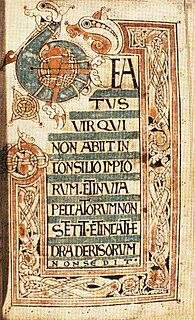 W
WThe Ricemarch Psalter is an 11th-century Welsh illuminated psalter, in a late Insular style, that has been described as "Hiberno-Danish", instead of the usual "Hiberno-Saxon", as it reflects Viking influence. Its 159 pages are vellum, and include the following sections: Letter of St. Jerome to Chromatius and Elidorus; Breviarius Apostolorum; Martyrologium Hieronymianum, and Various Tables. It is one of two surviving manuscripts from the scriptorium at Llanbadarn Fawr in Wales, established by the father of the scribe and the first owner. The other is a manuscript of St. Augustine's De Trinitate in Cambridge, by the same scribe. The psalter is now at Trinity College Dublin as MS 50.
 W
WThe Sofia Psalter, also known as Ivan Alexander's Psalter or the Kuklen Psalter, is a 14th-century Bulgarian illuminated psalter. It was produced in 1337 and belonged to the royal family of Tsar Ivan Alexander of Bulgaria.
 W
WThe Southampton Psalter is an Insular illuminated Psalter from Ireland. It is asserted by some to be from ninth-century in date, while other scholars have argued for a tenth- or even early eleventh-century dating. It has illuminations including three full page miniatures and also contains numerous annotations in both Latin and Old Irish.
 W
WThe Stowe Psalter is a psalter from the "2nd or 3rd quarter of the 11th century", at the end of Anglo-Saxon art. The text includes the Gallican version of the Psalms, followed by the Canticles with an interlinear Old English gloss.
 W
WThe Tiberius Psalter is one of at least four surviving Gallican psalters produced at New Minster, Winchester in the years around the Norman conquest of England. The manuscript can now be seen fully online at the British Library website.
The Tomić Psalter is a 14th-century Bulgarian illuminated psalter. Produced around 1360, during the reign of Tsar Ivan Alexander, it is regarded as one of the masterpieces of the Tarnovo literary and art school of the time. It contains 109 valuable miniatures.
 W
WThe Vespasian Psalter is an Anglo-Saxon illuminated psalter decorated in a partly Insular style produced in the second or third quarter of the 8th century. It contains an interlinear gloss in Old English which is the oldest extant English translation of any portion of the Bible. It was produced in southern England, perhaps in St. Augustine's Abbey or Christ Church, Canterbury or Minster-in-Thanet, and is the earliest illuminated manuscript produced in "Southumbria" to survive.
 W
WThe Westminster Psalter, British Library, MS Royal 2 A XXII, is an English illuminated psalter of about 1200, with some extra sheets with tinted drawings added around 1250. It is the oldest surviving psalter used at Westminster Abbey, and is presumed to have left Westminster after the Dissolution of the Monasteries. It joined the Old Royal Library as part of the collection of John Theyer, bought by Charles II of England in 1678. Both campaigns of decoration, both the illuminations of the original and the interpolated full-page drawings, are important examples of English manuscript painting from their respective periods.
 W
WPsalter World Map is the name historiography gave to a medieval world map that has been found in a psalter. This mappa mundi is now conserved at the British Library in London.